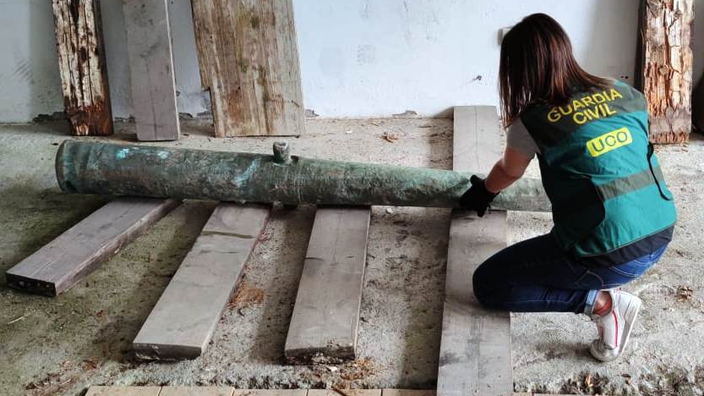Failing to have thundered against English ships, he will have at least scuttled a small group of Galician pirates.
A Spanish cannon weighing nearly 300 kg which would have belonged to one of the armadas chartered by Spain against Elizabethan England at the end of the 16th century has been found in Noia, in La Coruña, Spanish gendarmes announced on Wednesday. of the Guardia Civil.
The artillery piece was neither pilfered from a public place, nor even less stolen from the galleries of a museum but extirpated, in the most incredible of ways, from the seabed located off Espiñeirido, on the coast. Atlantic of Galicia.
Read also: Storms unearthed two shipwrecks from the 16th and 18th centuries on the Suffolk coast
The weapon, which appears to be made of bronze, belonged to a set of three guns identified at sea on April 14 by fishermen in the region. Immediately alerted to the discovery, heritage experts dispatched the next day on site and supported by an escort from the Guardia Civil found only two of the three submerged rooms mentioned. The Spanish cannon, however, had not vanished. According to the gendarmerie, it was under cover of night, just hours after the discovery that the object, centuries old, had been extracted from the floor of the Atlantic Ocean. Much facilitated by the posting on social networks of a video presenting the extraction of the weapon by its own looters, as well as by the contradictions of a group of suspects quickly identified, theinvestigation led to the arrest of 7 people and the happy rediscovery of the lost cannon.
The master builder of the plunder probably wanted to make the cannon a decorative object, according to the Spanish authorities.
Guardia Civil / EPA
The lost weapon of an aborted expedition
"We suspect that this looting was a whim of one of the interviewees, who thought the cannon would make a good decorative object
,
"
Guardia Civil said in a statement.
Entrusted to the archaeological service of the autonomous community of Galicia, the piece of artillery will finally be able to be preserved and examined by specialists who have yet to identify its precise origin.
With the two other guns - a little larger - recovered in April, this small arsenal discovered off the Spanish coast should eventually join the collections of the Maritime Museum in Vigo.
Read also: Six pirate bodies discovered in the wreckage of a ship sunk in 1717 near Cape Cod
Asked by El Español, underwater archaeologist Miguel San Claudio - who was involved in the recovery of the two guns - said the two pieces he sighted were bronze, 32-pound, and dated 1587 guns. .
"one of these pieces was probably pouring in Seville or Lisbon. For the other we have more doubts, perhaps Flanders. In all cases, they were made for the King of Spain, ”
he said, indicating that the guns are stamped with the crest of the Spanish crown. In the opinion of Galician experts, these could be pieces dated to the end of the 16th century, possibly those of a ship of the Spanish Armada of 1596. Also known as the
"Second Armada"
, this Spanish military expedition made up of a hundred vessels bound for Ireland had been nipped in the bud by a terrible storm which had shattered the momentum of the fleet off Cape Finisterre, on the Galician coast. This catastrophic failure came less than ten years after the first defeat of the Invincible Armada supposed to invade the British Isles in 1588, and a year before the rout of a third Spanish fleet.

